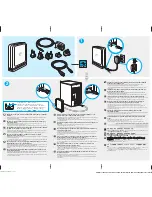
Designing Portal Use Case Scenarios
Chapter 5
Creating Your Portal Design
99
•
You can install Search on a machine separate from Portal Server, to keep the
main server dedicated to portal activity. When you do so, you use the
searchURL
property of the Search provider to point to the second machine
where Search is installed. The Search instance is a normal portal instance. You
install the Search instance just as you do the portal instance, but use it just for
Search functionality.
•
The size of the Search database dictates whether more than one machine needs
to host the Search database by replicating it across machines or building
module. Consider using high-end disk arrays.
•
Use a proxy server for caching the search hit results. When doing so, you need
to disable the document level security. See the Portal Server 6 Administration
Guide for more information on document level security.
Designing Portal Use Case Scenarios
Use case scenarios are written scenarios used to test and present the system’s
capabilities and form an important part of your high-level design. Though you
implement use case scenarios toward the end of the project, formulate them early
on in the project, once you have established your requirements.
When available, use cases can provide valuable insight into how the system is to be
tested. Use cases are beneficial in identifying how you need to design the user
interface from a navigational perspective. When designing use cases, compare
them to your requirements to get a thorough view of their completeness and how
you are to interpret the test results.
Use cases provide a method for organizing your requirements. Instead of a
bulleted list of requirements, you organize them in a way that tells a story of how
someone can use the system. This provides for greater completeness and
consistency, and also gives you a better understanding of the importance of a
requirement from a user perspective.
Use cases help to identify and clarify the functional requirements of the portal. Use
cases capture all the different ways a portal would be used, including the set of
interactions between the user and the portal as well as the services, tasks, and
functions the portal is required to perform.
A use case defines a goal-oriented set of interactions between external actors and
the portal system. (Actors are parties outside the system that interact with the
system, and can be a class of users, roles users can play, or other systems.)
Содержание Portal Server 6 2005Q1
Страница 8: ...8 Portal Server 6 2005Q1 Deployment Planning Guide...
Страница 10: ...10 Portal Server 6 2005Q1 Deployment Planning Guide...
Страница 12: ...12 Portal Server 6 2005Q1 Deployment Planning Guide...
Страница 20: ...Sun Welcomes Your Comments 20 Portal Server Secure Remote Access 6 2005Q1 Administration Guide...
Страница 36: ...A Typical Portal Server Installation 36 Portal Server 6 2005Q1 Deployment Planning Guide...
Страница 50: ...Proxylet 50 Portal Server 6 2005Q1 Deployment Planning Guide...
Страница 78: ...SRA Sizing 78 Portal Server 6 2005Q1 Deployment Planning Guide...
Страница 132: ...Identity and Directory Structure Design 132 Portal Server 6 2005Q1 Deployment Planning Guide...
Страница 142: ...Configuration Files 142 Portal Server 6 2005Q1 Deployment Planning Guide...
Страница 152: ...Tuning Parameters for etc system 152 Portal Server 6 2005Q1 Deployment Planning Guide...
Страница 158: ...Portal Server on an Application Server Cluster 158 Portal Server 6 2005Q1 Deployment Planning Guide...
Страница 178: ...Portal Design Task List 178 Portal Server 6 2005Q1 Deployment Planning Guide...
Страница 180: ...Comparison of Solaris and Linux Path Names 180 Portal Server 6 2005Q1 Deployment Planning Guide...
Страница 182: ...182 Portal Server 6 2005Q1 Deployment Planning Guide...
Страница 192: ...Section X 192 Portal Server 6 2005Q1 Deployment Planning Guide...
















































